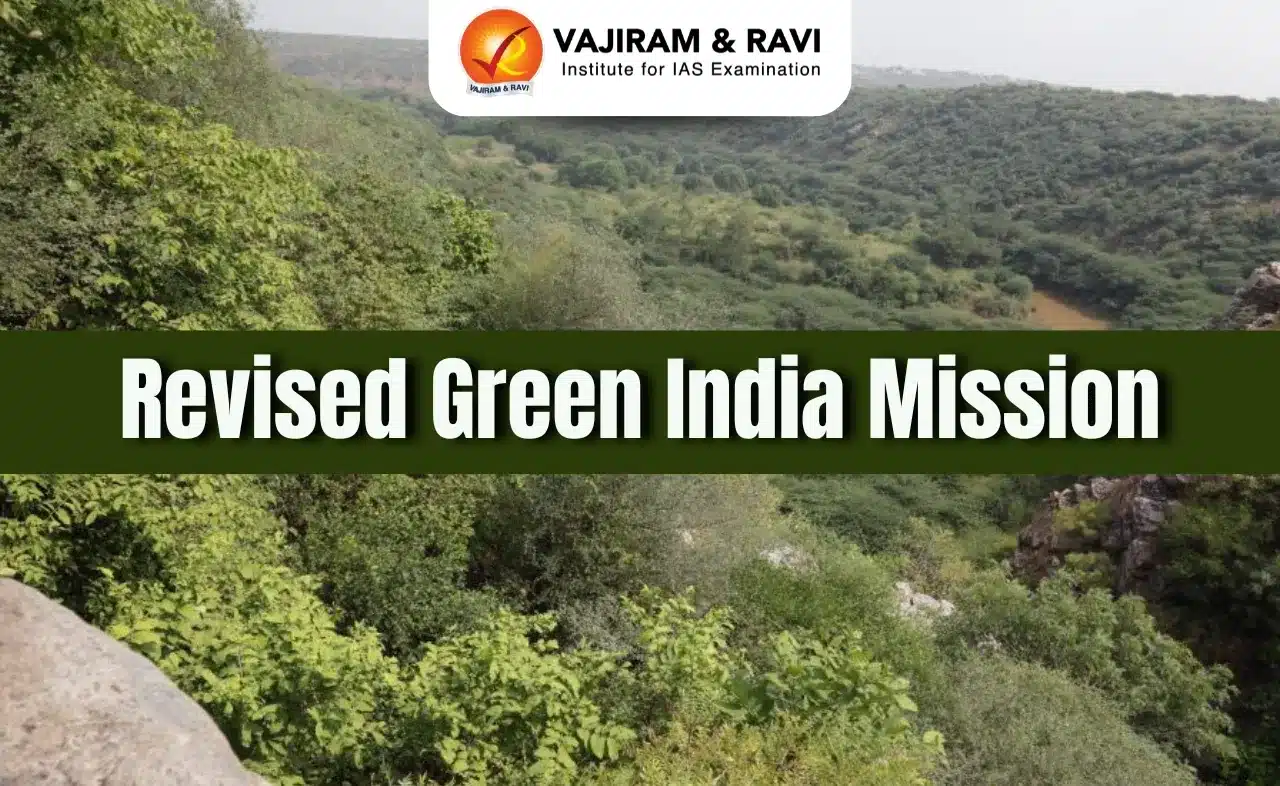Revised Green India Mission Latest News
- The Centre released a revised roadmap for the National Mission for Green India (GIM).
- The updated plan emphasizes not just increasing and restoring forest and green cover, but also focuses on ecological restoration in critical regions such as the Aravalli ranges, Western Ghats, Himalayas, and mangroves.
- As a key part of India’s climate action strategy, the revised GIM will also address land degradation and desertification, expanding its role in building environmental resilience.
Achievements of the Green India Mission (GIM)
- Background
- Launched in 2014 under the National Action Plan on Climate Change (NAPCC), the Green India Mission aims to:
- Increase forest and tree cover on 5 million hectares
- Improve the quality of forest cover on another 5 million hectares
- Restore degraded ecosystems and enhance livelihoods of forest-dependent communities
- Launched in 2014 under the National Action Plan on Climate Change (NAPCC), the Green India Mission aims to:
- Afforestation Progress
- From 2015-16 to 2020-21, the mission supported tree plantation and afforestation across 11.22 million hectares through various central and state schemes.
- Funding and Utilisation
- Between 2019-20 and 2023-24, the Centre allocated ₹624.71 crore to 18 states for GIM-related interventions, of which ₹575.55 crore has been utilised.
- Targeted Implementation
- GIM activities are prioritized in states based on:
- Ecological vulnerability
- Carbon sequestration potential
- Forest and land degradation levels
- Restoration potential
- GIM activities are prioritized in states based on:
Revised Green India Mission: Key Highlights
- Need for Revision
- The Green India Mission (GIM) roadmap has been revised based on:
- Ground-level climate impacts
- Feedback from implementing partner states
- Recommendations from scientific institutions
- The updated plan adopts a region-specific, ecologically tailored approach.
- The Green India Mission (GIM) roadmap has been revised based on:
- Focus on Vulnerable Landscapes
- The revised mission prioritizes restoration and saturation of vulnerable landscapes, including:
- Aravalli ranges
- Western Ghats
- Indian Himalayas
- Mangrove ecosystems
- Best practices will be adapted to local ecological conditions for effective restoration.
- The revised mission prioritizes restoration and saturation of vulnerable landscapes, including:
- Integration with Aravalli Green Wall Project
- GIM will align with the Centre’s Aravalli Green Wall Project to:
- Combat degradation and desertification
- Close 12 ecological gaps contributing to dust storms in Delhi-NCR and Punjab
- Initially restore 8 lakh hectares across 29 districts and 4 states
- Use native plant species, restore grasslands, forests, and water systems
- Estimated cost: ₹16,053 crore
- Aim: Create a 5-km buffer zone covering 6.45 million hectares
- GIM will align with the Centre’s Aravalli Green Wall Project to:
- Action in the Western Ghats
- In the Western Ghats, GIM will focus on: Afforestation efforts; Groundwater recharge; Eco-restoration of abandoned mining zones.
- This is in response to threats from deforestation, degradation, and illegal mining.
- The revised roadmap reflects a strategic, region-sensitive approach to ecological restoration and climate resilience.
Revised Green India Mission: Strategy to Combat Land Degradation and Desertification
- Scale of the Challenge
- According to ISRO’s Desertification and Land Degradation Atlas, about 97.85 million hectares (one-third of India’s land) faced degradation in 2018–19.
- National Climate Commitment
- India has pledged to:
- Create an additional carbon sink of 2.5–3 billion tonnes of CO₂ by 2030 through increased forest and tree cover
- Restore 26 million hectares of degraded land by 2030 under its international climate commitments (UNFCCC)
- India has pledged to:
- Role of Natural Ecosystems
- Natural carbon sinks—forests, wetlands, grasslands, and mountain ecologies—will help:
- Absorb greenhouse gas emissions
- Act as natural buffers against the impacts of climate change
- Natural carbon sinks—forests, wetlands, grasslands, and mountain ecologies—will help:
- Contributions So Far
- Between 2005 and 2021, India created an additional carbon sink of 2.29 billion tonnes of CO₂ equivalent, as per a statement in the Lok Sabha.
- Focus on Restoring Open Forests
- The revised GIM identifies impaired open forests as key areas for restoration:
- Cost-effective and high-impact for carbon sequestration
- Forest Survey of India (FSI) estimates this strategy alone could sequester 1.89 billion tonnes of CO₂ across 15 million hectares.
- The revised GIM identifies impaired open forests as key areas for restoration:
- Target for Expanded Tree Cover
- By integrating ongoing schemes and boosting afforestation:
- GIM could expand forest and tree cover to 24.7 million hectares
- This could generate a carbon sink of 3.39 billion tonnes CO₂ by 2030, exceeding India’s climate targets
- By integrating ongoing schemes and boosting afforestation:
- In essence, the revised GIM aligns ecological restoration with India’s climate goals, making forests a cornerstone in the fight against land degradation and global warming.
Last updated on January, 2026
→ Check out the latest UPSC Syllabus 2026 here.
→ Join Vajiram & Ravi’s Interview Guidance Programme for expert help to crack your final UPSC stage.
→ UPSC Mains Result 2025 is now out.
→ UPSC Notification 2026 is scheduled to be released on January 14, 2026.
→ UPSC Calendar 2026 has been released.
→ UPSC Prelims 2026 will be conducted on 24th May, 2026 & UPSC Mains 2026 will be conducted on 21st August 2026.
→ The UPSC Selection Process is of 3 stages-Prelims, Mains and Interview.
→ Prepare effectively with Vajiram & Ravi’s UPSC Prelims Test Series 2026 featuring full-length mock tests, detailed solutions, and performance analysis.
→ Enroll in Vajiram & Ravi’s UPSC Mains Test Series 2026 for structured answer writing practice, expert evaluation, and exam-oriented feedback.
→ Join Vajiram & Ravi’s Best UPSC Mentorship Program for personalized guidance, strategy planning, and one-to-one support from experienced mentors.
→ UPSC Result 2024 is released with latest UPSC Marksheet 2024. Check Now!
→ UPSC Toppers List 2024 is released now. Shakti Dubey is UPSC AIR 1 2024 Topper.
→ Also check Best UPSC Coaching in India
Revised Green India Mission FAQs
Q1. What is the Revised Green India Mission? +
Q2. Why was the Green India Mission updated? +
Q3. What is the Aravalli Green Wall Project? +
Q4. How much forest area has GIM covered so far? +
Q5. What are India’s 2030 restoration goals under GIM?+
Tags: mains articles revised green india mission upsc current affairs upsc mains current affairs

















